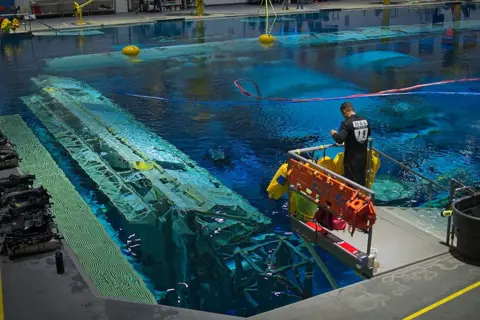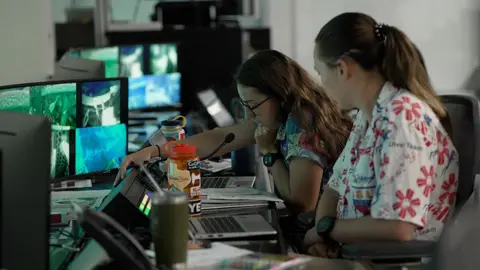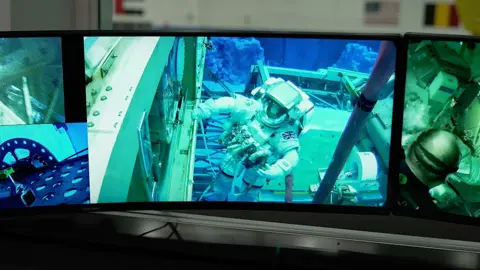Rosemary’s training here covers every aspect of going to space – including learning how to use the onboard toilet.
“The lower part is where you put your solid waste,” she says, pointing to a loo in a small cubicle that looks like something you might find at a very old campsite. “And this funnel here is actually attached to an air suction system, and that is where you put your liquid waste.”
Female astronauts have the option of suppressing their periods using drugs, Rosemary says, but can also opt not to.
“There’s essentially a filter that you put on top of the cone in which you urinate and it’s to stop any particles, any blood, from going into the urine system.”
Urine needs to be kept separate because it’s purified and treated to be re-used as drinking water, she explains.
 Kevin Church/BBC
Kevin Church/BBCBack in the pool, divers are constantly adjusting Rosemary’s buoyancy in the water to make the experience as close as possible to microgravity.
She moves around painstakingly, making sure she’s always attached to the submerged structure using two hooks.
Every hand-hold is carefully chosen along the bars on the outside of each module. They’re in exactly the same positions as the ones on the real thing, vital muscle memory if she gets to carry out a spacewalk 200 miles (322km) above the Earth.
It’s slow and difficult work, requiring plenty of upper body strength and physical effort in the hot, bulky spacesuit.
“You do a lot of mental preparation – you really think through every single movement,” Rosemary explains. “You have to be really efficient with your energy. You don’t want to do something and realise it wasn’t quite right and have to do it again.”
 Kevin Church/BBC
Kevin Church/BBC Kevin Church/BBC
Kevin Church/BBCRosemary is working alongside another astronaut to complete a list of space station repairs and maintenance for the test. Her every move is monitored by a team in a control room overlooking the pool. They’re in constant communication with her as she works through her tasks.
Former space station commander Aki Hoshide, from the Japan Aerospace Exploration Agency, is on hand for advice. He has completed four spacewalks and says it’s a steep learning curve for new astronauts.
“When we first start out, there’s so much information thrown at you, so many skills that you have to learn and show and demonstrate,” he says. “It is baby steps, but they are moving forward – and I can see their excitement every time they come here and jump in the pool.”
Rosemary takes us to see a Saturn V – the rocket that took the Apollo astronauts to the Moon in 1969. More than 50 years on, Nasa is planning an imminent return to the lunar surface with its Artemis programme. European astronauts will join later missions. With an expected 35-year space career ahead, Rosemary may one day get the chance to become the first Briton to walk on the Moon.
“It’s incredibly exciting that we, as humanity, are going back to the Moon, and of course, any way that I could be a part of that, I would be absolutely delighted. I think it’s absolutely thrilling,” she says.
After six gruelling hours underwater, Rosemary is nearing the end of her spacewalk test – but then she’s thrown a curve ball.
In the control room, we hear her call out for a comms check with her astronaut partner who’s working on another part of the space station. But she’s met with silence.
On a video screen, we can see he’s motionless. Rosemary doesn’t know it, but he’s been asked to pretend to lose consciousness. Rosemary’s job is to reach him, check his condition – and tow him back to the airlock.
After so long under water, we can see how exhausted she is – but working slowly and steadily, she gets him safely to the airlock.